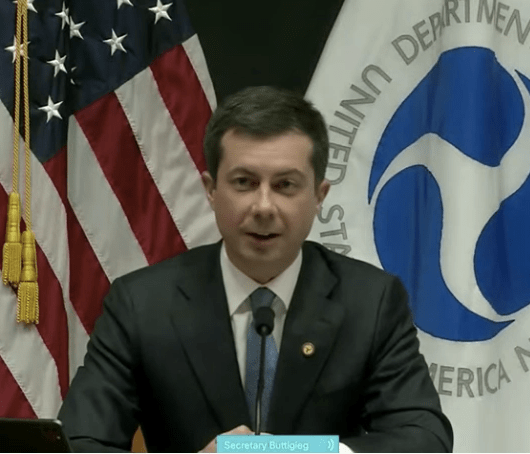At Thursday’s House Transportation and Infrastructure Committee Hearing, U.S. Transportation Secretary Pete Buttigieg presented the Biden Administration’s commitment to investing in transit, freight and passenger rail, and Complete Streets programs, as well as the transition to electric vehicles.
In a marathon session covering the diverse concerns of representatives from urban, suburban, rural, coastal and heartland districts, Buttigieg answered questions about the Biden administration’s priorities for a proposed $2.6 trillion infrastructure package – the largest federal investment in surface transportation since the Eisenhower administration’s Federal Highway Act that built the Interstate highway system, fueling sprawl and devastating lower-income communities of color along the way. The Biden infrastructure bill is an ambitious vision for a more forward-thinking approach to surface transportation infrastructure that Buttigieg and committee Peter DeFazio, the U.S. Representative for Oregon’s 4th congressional district, a Democrat, stated will be “built back better” to mitigate climate change impacts, improve safety, and increase equity and access for communities harmed by disinvestment and inequitable past transportation policies. Chairman DeFazio said in his opening statement, “We won’t be doing Eisenhower 8.0.”
Questions from dozens of Congressional reps during the five-hour-plus session ranged from wastewater management to fixing leaks in natural gas pipelines (a major source of greenhouse gas emissions) to shortages of freight shipping containers. Happily, sustainable transportation issues were at the fore, along with de rigueur questions from the right side of the aisle about how to pay for them.
The first couple our hours focused heavily on transitioning private cars, heavy freight and buses to electric vehicles and building charging stations. One long-term funding concern was the decline of “user fees” as more drivers transition to EVs and gas tax revenue drops. Buttigieg spoke favorably of taxes based on vehicle miles traveled as a new “user fee” model – a system not without potential issues, both in terms of privacy concerns and, as Representative Doug LaMalfa of California, a Republican, pointed out, hitting people living in rural, economically depressed areas – not to mention urban areas underserved by transit, often low-income and Black and brown neighborhoods – especially hard. Of course, as it stands, these same car-dependent demographics, who are unlikely to drive electric cars, pay gas tax that’s proportionate to the amount of driving they do.
It was encouraging that Buttigieg presented the transition to low- and no-emission vehicles as just one part of a larger vision that includes the expansion of multimodal transportation and the construction of intercity high-speed rail. But it was disappointing that the secretary was reluctant to commit to revising the longstanding 80/20 funding split that gives four times as much funding to car infrastructure than transit, and provides almost no dollars for transit maintenance, only capital projects. When Representative Hank Johnson, a Democrat from Georgia, asked if Buttigieg would support changing the split, the secretary skirted the question, stating a commitment to funding transit but remaining vague on whether he would reconsider the funding split until further pressed by Johnson.
Buttigieg did however clearly state a commitment to providing more funding for transit operations. “Only funding capital costs, but not operating costs, can set up a cycle where new infrastructure is built that then increases operating costs. It’s a good time to look at that.”
The secretary also committed to a more equitable approach to all surface transportation projects. When Representative Anthony Brown, a Democrat from Maryland, cited the harm inflicted by the state’s highway system, which was built without community input or considering improved transit service as an alternative, Buttigieg replied, “We’ve got to make sure we’re creating options and infrastructure for Americans of every background and income level. We want transit to be a means of choice for as many people as possible. A misguided investment can exacerbate problems or can be a temporary fix that doesn’t deal in a holistic way with how people get around. We have the opportunity to expand prosperity, but it needs to be deployed in ways that take community input into consideration, highway, rail or any other mode.”
It felt almost revolutionary to hear a U.S. transportation chief acknowledge that maximizing vehicle speed should not be the only consideration in road design, and enthusiastically embrace Complete Street plans. Buttigieg pointed more than once to a successful street conversion in downtown South Bend completed while he was mayor, saying “The idea of Complete Streets is to make sure our streets are set up to accommodate all kinds of travel. Safe for pedestrians, accessible for bikes and wheelchairs…We need to make sure these kind of gains are available to communities across the country, and provide federal funding to communities taking this approach. Efficiency of vehicle traffic is important, but roads have to be places where vehicles, bikes, pedestrians and businesses coexist peacefully.” (Some South Bend residents blamed Buttigieg for the death of an 11-year-old boy who was fatally struck by a driver at an intersection where a stoplight was deactivated as part of the city’s Smart Streets program.)
Missing from the conversation was a clear definition of peaceful coexistence. In the past Buttigieg has talked about reducing traffic fatalities, which rose to almost 38,000 nationwide in 2019, but there was no mention of Vision Zero or other measurable safety goals during the five-hour hearing. And while it was nice to hear the administration’s interest in increasing access for pedestrians, especially people with disabilities and seniors, there was no talk of mandating ADA compliance for street projects – the kind of meaningful regulation that enforces real change.
Overall, Buttigieg presented an ambitious vision for a more just and sustainable transportation system in the U.S. We’ll be eagerly following the funding, regulation and policy specifics of how this vision can be realized.






